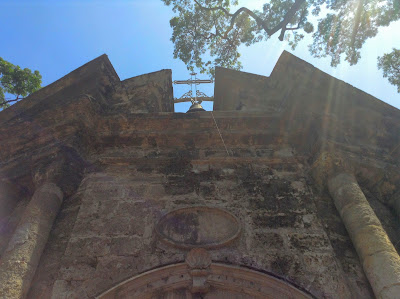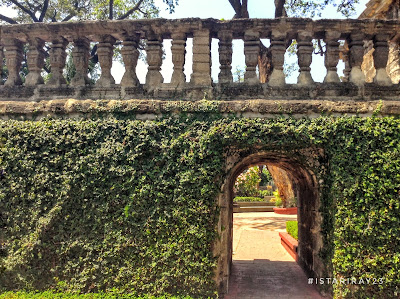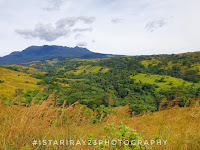I also used to work for the Parish Church which handles this little chapel which is St. Vincent de Paul Parish Church located in front of Adamson University.
Weddings were being held in this place and if we only knew way back then this chapel was only used to hold masses for the dead.
Scary Isn't it?
However, as time passed by that particular thinking is no longer entertained.
Today Paco Park stands as a landmark, a heritage place, and a park where the wedding ceremony and reception are being held.
Sometimes the park became a pictorial and shooting ground for magazine commercials and movies.

St. Pancratius Chapel
Inside the Paco, Cemetery is a chapel dedicated to St. Pancratius, a Roman citizen who converted to Christianity and was beheaded for his faith at the age of just 14 around the year 304. His name is Greek and literally means "the one that holds everything."
The chapel is under the care of the San Vicente de Paul Parish and the Vincentian fathers who also manage the nearby Adamson University.
- https://en.wikipedia.org/wiki/Paco_Park
According to an on-site inscription, an order for the construction of a cemetery in Bagumbayan was issued in 1807, due to the outbreak of a cholera epidemic in Manila.
Maestro de Obras Don Nicolas Ruiz developed a plan for the Paco Cemetery, while Don Jose Coll served as supervisor of the construction work. The cemetery was primarily designed as a municipal cemetery for the affluent and established aristocratic Spanish families who resided in the old Manila or the city within the walls of Intramuros during the Spanish colonial era.
It was on April 22, 1822, when the cemetery was officially inaugurated, although it had been in use for two years before its completion.
For the amount of Php 19,700, a Chinese builder won the bid to build the outer portion of the cemetery. At that time, the niches cost Php 20 for three years, which was subject to renewals as no one was granted the privilege to own the niches in perpetuity.
On December 30, 1896, Philippine national hero Dr. José Rizal was interred at Paco Park after his execution at Bagumbayan.
Interment at the Paco Cemetery ceased in 1912. It had been the burial ground for several generations and descendants of those buried in the park had the remains of their ancestors exhumed and transferred to other cemeteries in Manila.

One notable aspect of Paco Park is its circular shape, which was designed by Spanish architect and engineer Nicolas Ruiz. The park was initially intended for the elite and noble families of Manila to serve as their final resting place. However, it later became a venue for public executions during the Spanish era.




Dr. José Protasio Rizal, Philippine National Hero, was secretly interred at Paco Park after his execution at Bagumbayan on December 30, 1896, and was guarded for fifteen days by the Guardia Civil Veterans. His remains were exhumed on August 17, 1898, and on December 30, 1912, were laid underneath the monument dedicated to him at the Luneta as stated in the Park's marker.
- https://en.wikipedia.org/wiki/Paco_Park
Fr. Jose A. Burgos, Fr. Mariano C. Gomes, and Fr. Jacinto R. Zamora's mortal remains after their execution on February 17, 1892, were buried in the cemetery grounds as they were linked to the Cavite Mutiny, as stated in the Park's marker.
- https://en.wikipedia.org/wiki/Paco_Park
Paco Park is maintained by National Park’s Development Committee (NPDC) and the chapel is under the jurisdiction of San Vicente de Paul Parish, Ermita, Manila.
Address: Belen, Paco, Manila, Metro Manila
Business Hours: Mondays to Sundays 8AM to 5PM
Entrance Fee: Php 5.00
Weddings were being held in this place and if we only knew way back then this chapel was only used to hold masses for the dead.
Scary Isn't it?
However, as time passed by that particular thinking is no longer entertained.
Today Paco Park stands as a landmark, a heritage place, and a park where the wedding ceremony and reception are being held.
Sometimes the park became a pictorial and shooting ground for magazine commercials and movies.
The Paco Park (originally named as Cementerio General de Dilao) is a recreational garden and was once Manila's municipal cemetery built by the Dominicans during the Spanish colonial period. It is located on General Luna Street and at the east end of Padre Faura Street in Paco, Manila, Philippines.
- https://en.wikipedia.org/wiki/Paco_Park
Paco Park Cemetery, located in Manila, Philippines, is a historic park and burial site that holds significance in the country's history. It was originally built as a municipal cemetery during the Spanish colonial period in the late 18th century. The park gets its name from the nearby district of Paco.
St. Pancratius Chapel
Inside the Paco, Cemetery is a chapel dedicated to St. Pancratius, a Roman citizen who converted to Christianity and was beheaded for his faith at the age of just 14 around the year 304. His name is Greek and literally means "the one that holds everything."
The chapel is under the care of the San Vicente de Paul Parish and the Vincentian fathers who also manage the nearby Adamson University.
- https://en.wikipedia.org/wiki/Paco_Park
According to an on-site inscription, an order for the construction of a cemetery in Bagumbayan was issued in 1807, due to the outbreak of a cholera epidemic in Manila.
Maestro de Obras Don Nicolas Ruiz developed a plan for the Paco Cemetery, while Don Jose Coll served as supervisor of the construction work. The cemetery was primarily designed as a municipal cemetery for the affluent and established aristocratic Spanish families who resided in the old Manila or the city within the walls of Intramuros during the Spanish colonial era.
It was on April 22, 1822, when the cemetery was officially inaugurated, although it had been in use for two years before its completion.
In 1859, Governor Fernándo Norzagaray y Escudero proposed the extension of the cemetery to approximately 4,500 square yards, enclosing the original plan with another circular outer wall.
For the amount of Php 19,700, a Chinese builder won the bid to build the outer portion of the cemetery. At that time, the niches cost Php 20 for three years, which was subject to renewals as no one was granted the privilege to own the niches in perpetuity.
On December 30, 1896, Philippine national hero Dr. José Rizal was interred at Paco Park after his execution at Bagumbayan.
Interment at the Paco Cemetery ceased in 1912. It had been the burial ground for several generations and descendants of those buried in the park had the remains of their ancestors exhumed and transferred to other cemeteries in Manila.

One notable aspect of Paco Park is its circular shape, which was designed by Spanish architect and engineer Nicolas Ruiz. The park was initially intended for the elite and noble families of Manila to serve as their final resting place. However, it later became a venue for public executions during the Spanish era.


Over the years, Paco Park Cemetery has witnessed various historical events and has served as a burial site for many prominent figures. The remains of notable Filipino heroes, including Dr. Jose Rizal, were briefly interred in Paco Park before being transferred to other final resting places.

Today, Paco Park Cemetery is a tranquil and picturesque public park, attracting visitors who appreciate its historical and architectural value. Its lush greenery, beautiful gardens, and old walls make it a popular spot for weddings, concerts, and cultural events. The park also features a chapel, which still hosts weddings and religious ceremonies.
Paco Park Cemetery stands as a reminder of Manila's rich history and serves as a peaceful retreat within the bustling cityscape.

Dr. José Protasio Rizal, Philippine National Hero, was secretly interred at Paco Park after his execution at Bagumbayan on December 30, 1896, and was guarded for fifteen days by the Guardia Civil Veterans. His remains were exhumed on August 17, 1898, and on December 30, 1912, were laid underneath the monument dedicated to him at the Luneta as stated in the Park's marker.
- https://en.wikipedia.org/wiki/Paco_Park
The grave that has no mark inside this place during the Spanish era is the grave of our national hero Dr. Jose Rizal.
This one reminds me of the lamp post in the movie Narnia
Paco Park is circular in shape, with an inner circular fort that stood as the original cemetery. Its walls were made hollow to serve as niches, and as the population continued to grow, a second outer wall was built with thick adobe walls. The top of the walls was then made into pathways for promenades. A small, domed Roman Catholic chapel was also built inside the walls of the park and was dedicated to St. Pancratius.
Ildefonso P. Santos, Jr., a noted landscape architect who was given recognition as a Philippine National Artist, was involved in the design of Paco Park.[1]
- https://en.wikipedia.org/wiki/Paco_Park
Tombs with No Mark
Fr. Jose A. Burgos, Fr. Mariano C. Gomes, and Fr. Jacinto R. Zamora's mortal remains after their execution on February 17, 1892, were buried in the cemetery grounds as they were linked to the Cavite Mutiny, as stated in the Park's marker.
- https://en.wikipedia.org/wiki/Paco_Park
Paco Park is maintained by National Park’s Development Committee (NPDC) and the chapel is under the jurisdiction of San Vicente de Paul Parish, Ermita, Manila.
Address: Belen, Paco, Manila, Metro Manila
Business Hours: Mondays to Sundays 8AM to 5PM
Entrance Fee: Php 5.00
This site is for the infant who died during the cholera epidemic in the country.
#PacoPark,
#PacoParkManila,
#PacoParkManilaPH,
#PacoParkCemetery,
#ManilaPacoPark,
#istariray23photography,
#istariray23Laboy,
#istariray23travel,


























































